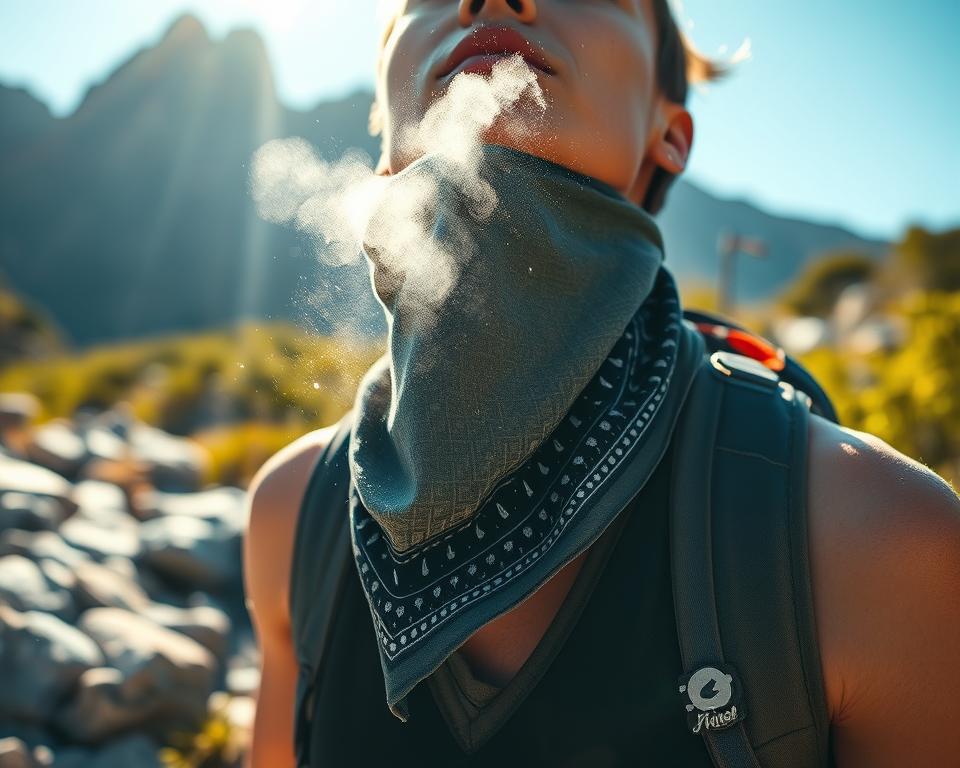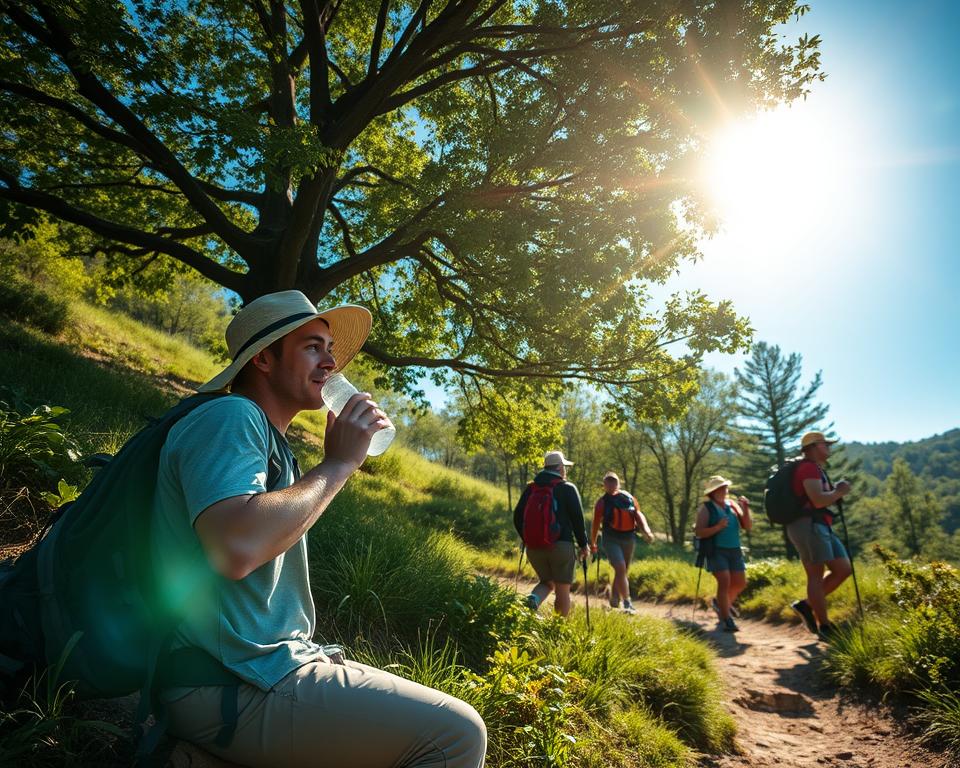Hiking in the summer is exciting. But temperatures can soar over 105°F. It’s crucial to follow hiking safety tips to prevent heat stroke and heat issues. Many hikers have faced dangers due to poor hike planning and being unprepared for the heat.
It doesn’t matter if you’re experienced or new to hiking. Knowing how to handle outdoor heat safety is key. In this article, we’ll cover 10 ways to stay cool and safe while hiking in the heat. You’ll learn from experts and get tips backed by stats, to keep you hydrated and well on your journey.
Plan Your Hike Around Peak Temperatures
When planning a hike, timing is crucial, especially in the hot summer. You must consider the day’s peak temperatures. Hiking when it’s too hot is not only uncomfortable but risky.
Scout Out Shaded Trails
Shaded trails are a game-changer. They offer relief from the harsh sun. Look for paths with lots of trees. They can make it feel up to 20 degrees cooler. This step greatly improves your hiking.
Choose High-Elevation Routes
High-elevation hikes offer cooler air. Higher places are often much cooler than the lowlands. You’ll escape the heat, see amazing views, and enjoy a refreshing environment.
Hike at Dawn or Dusk
Hiking early in the morning or late in the evening is ideal. These times avoid the day’s hottest heat. Since peak heat is around 3pm, hiking early or late ensures a cooler, safer experience.
Understand and Identify Symptoms of Heat-Related Illnesses
Knowing the signs of heat-related illnesses is key to acting fast. This knowledge can prevent heat stroke, heat exhaustion, and heat cramps.
Heat Stroke Symptoms
Heat stroke is a serious condition. Look for these heat stroke identification signs:
- Body temperature over 104°F
- Confusion and delirium
- Seizures
- Dizziness and weakness
- Rapid, strong pulse
- No sweating despite the heat
Get medical help right away if these symptoms appear to avoid worse health issues.
Heat Exhaustion Symptoms
Heat exhaustion can lead to heat stroke. It happens due to too much heat or physical work. Watch for these heat exhaustion signs:
- Heavy sweating
- Rapid, weak pulse
- Nausea and vomiting
- Dizziness and headaches
- Skin feels tingly
- Feeling irritable and very tired
Follow CDC guidelines if you see these signs. Move to a cool place, drink water, and rest.
Heat Cramps Symptoms
Heat cramps hurt and happen during hard exercise in the heat. Look out for:
- Muscle pains or spasms in the abdomen, arms, or legs
- Lots of sweating during intense exercise
For heat cramps, rest in a cool area, drink fluids, and do gentle stretches.
Knowing these signs and following CDC guidelines can keep you safe. It helps you act quickly when needed.
Wear Proper Clothing and Gear
What you wear when hiking can greatly affect your comfort and safety. The right clothes and gear keep you cool, dry, and safe from the sun. Here are some key tips for picking the best hiking attire.
Light-Colored and Cotton Clothing
Choosing light-colored clothes is wise because they reflect the sun and keep you cooler. Cotton clothes may not wick moisture like technical fabrics, but they’re breathable. This helps regulate your body temperature and prevents overheating during hikes.
Wide-Brimmed Hats and Sunglasses
A wide-brimmed hat, like the Solbari Traveller Broad Brim Sun Hat with UPF 50+, protects your face, neck, and ears from the sun. Sunglasses, such as the Knockaround Fast Lanes Sport Polarized Sunglasses with UV400, are also crucial. They protect your eyes from harmful UV rays. These accessories are key for avoiding sunburn and other heat-related problems.
Ventilated and Breathable Fabrics
Wear clothes made from breathable fabrics like polyester, nylon, or merino wool to enhance your hike. These materials wick moisture away, keeping you dry and comfy. Merino wool is great because it breathes well and protects from the sun with a UPF of 20+.
Using these clothing tips will make your hikes more comfortable. It’s important to choose light, breathable fabrics and essential items like hats and sunglasses. Whether you are in Bryce Canyon or another hot place, these choices will help you stay cool and safe.
Stay Hydrated
When you’re hiking in hot weather, the right amount of water is vital. It can turn a hike from dangerous to memorable. Keeping up with your water intake is key, not just for being comfortable, but for staying safe. Here are some tips to stay hydrated.
Increase Water Intake
Under the hot sun, you should drink about a quart of water every hour. Thirst doesn’t always show how much water our bodies need. Drink more than you think you should. This is super important for kids and older people. They get dehydrated easier. If you catch dehydration early, you can avoid serious issues like heat stroke.
Carry Electrolytes
Just drinking water might not be enough for your electrolyte balance. Try eating salty snacks or adding hydration tablets to your water. A sports drink with electrolytes helps too. It keeps you hydrated and energized. Bananas, citrus fruits, and tomato juice are great for getting electrolytes.
Monitor Your Urine Color
Checking your urine color helps you know if you’re hydrated. Dark urine means you might be dehydrated. Clear urine could mean you’re drinking too much. Finding the right balance supports your health during the hike. If you feel a headache, get dizzy, or feel sick, you might be dehydrated.
By following these hydration tips, and keeping an eye on your intake, you’ll balance your electrolytes and spot dehydration early. Stay safe and enjoy your hike by staying hydrated!
How to Avoid Heat Stroke on the Trail
To prevent heat stroke while hiking, adopt key strategies. Resting often in the shade lowers core temperature and keeps your pace safe. If there’s no natural shade, use a tarp or umbrella to make your own.
Rest in the Shade Frequently
Resting in shaded spots is a top way to cool down. In hot, dry weather, dehydration and heat illnesses can come on fast. For desert hikes, like at Saguaro, carry 4 to 6 liters of water. This ensures you stay hydrated and cool.
Cool Your Body Down
Wetting your clothes, sitting in streams, or using a wet bandana on your neck helps prevent heat stroke. Runner Patrick Reagan suggests drinking twice as much water on hot days. These acts prevent heat exhaustion and heat stroke, especially on tough trails.
Plan for Lower Mileage Hikes
Adjust your hike’s pace and plan according to the temperature to avoid heat stroke. Choosing shorter hikes reduces time in the heat and hard work. Start hiking at sunrise and aim to finish by 10 a.m. This avoids the peak heat. Remember your limits and avoid pushing too hard to keep hiking safe and fun.
Utilize Cooling Techniques
Using cooling techniques while hiking helps you avoid heat stroke. Methods like wearing wet clothes help you stay safe and comfy. Cooling down this way is especially useful on hot trails.

Wet Clothing and Accessories
Evaporative cooling works well with wet clothing and gear. Just wetting a shirt or socks can cool you down. This is vital when it’s extremely hot outside. The evaporating water cools you off naturally.
Cooling Towels and Scarves
Cooling towels and scarves are great for staying cool. Soak them in water, then put them on your neck or head. They stay cool for a long time thanks to evaporative cooling. These are essential items for hiking in hot weather.
Soaking Your Hat in Water
Wetting your hat and wearing it is another good strategy. It cools you down using evaporative cooling. Dip your hat in a stream or spare water. As it dries, your head and body cool down, helping you stay safe from the heat.
How Can I Avoid Heat Stroke While Hiking to Hot Springs in Hot Weather?
When hiking to hot springs in hot weather, it’s crucial to stay hydrated and take regular breaks in shaded areas. Dress in lightweight, breathable clothing and apply sunscreen to protect your skin. To enhance your adventure, research and discover the best hot springs trails to ensure a safe and enjoyable experience.
Conclusion
Getting ready and knowing what to do are key to avoid heat stroke. When looking at hiking health tips, following certain steps helps lessen hot weather risks. Plan your hike for cooler times, pick the right clothes, stay hydrated, and use ways to cool down. This will make your hike safer and more fun.
Knowing the signs of heat illness lets you act fast. Being aware helps keep you safe outdoors. This means changing your pace, resting often, or choosing a cooler path. For more on managing heat and staying hydrated, check out this study.
Also, hike in shaded places, start early, and pick easier trails. Our aim is to enjoy nature safely, not just to explore new paths. If it’s too hot, think about your health first. You might need to hike another day. Trails can wait, but heat dangers are real.

